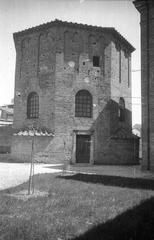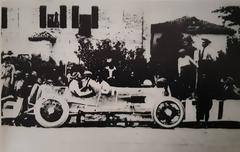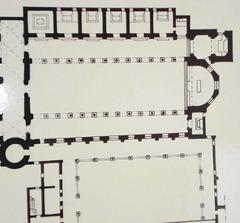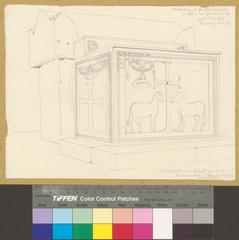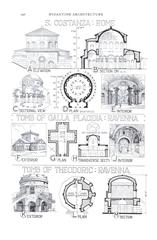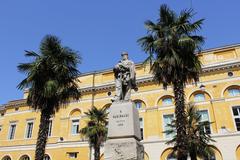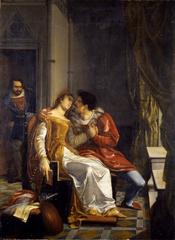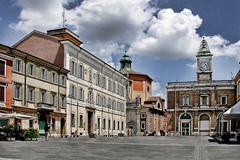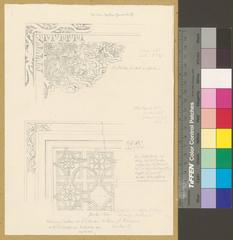Visiting the Early Christian Monuments of Ravenna, Italy: Tickets, Hours, and Travel Tips
Date: 14/06/2025
Introduction
Nestled in Italy’s Emilia-Romagna region, Ravenna is celebrated for its extraordinary collection of early Christian and Byzantine monuments. As a city that served as the capital of the Western Roman Empire, the Ostrogothic Kingdom, and the Byzantine Exarchate, Ravenna’s architecture and mosaics vividly reflect the cultural, religious, and artistic transformations of Late Antiquity. The city’s eight UNESCO World Heritage Sites, inscribed in 1996, offer a unique window into Europe’s early Christian heritage and the evolution of its sacred spaces (italybeyondtheobvious.com; italianamerican.com).
This in-depth guide provides essential information on Ravenna’s UNESCO monuments, including historical context, practical visiting tips, ticketing details, accessibility, and recommendations for making the most of your visit. Whether you are passionate about art, history, or simply looking for an inspiring travel destination, Ravenna promises an immersive and unforgettable experience (visititaly.eu; touristsecrets.com; european-traveler.com; fullsuitcase.com).
Historical Context and Significance
Ravenna’s Transformation and UNESCO Heritage
In 402 CE, Ravenna was designated the capital of the Western Roman Empire, ushering in a period of political and cultural prominence. The city’s marshland location ensured strategic security and facilitated its emergence as a cosmopolitan center. Following the empire’s collapse, Ravenna became the capital of the Ostrogothic Kingdom under Theodoric the Great and later the Byzantine Exarchate of Italy. Each era left its mark, resulting in a remarkable synergy of Roman, Ostrogothic, and Byzantine influences visible in Ravenna’s monuments (italybeyondtheobvious.com; italianamerican.com).
The Edict of Milan and Christian Art
The Edict of Milan in 313 CE, issued by Emperor Constantine, granted Christians the freedom to worship openly, leading to the conversion of pagan temples into Christian basilicas (visititaly.eu). In Ravenna, this transformation is evident in the city’s early Christian structures, which blend Roman architectural forms with new Christian iconography and liturgical needs.
The Mosaics: Technique, Symbolism, and Preservation
Ravenna’s mosaics are renowned for their vibrant colors, gold backgrounds, and intricate detail. Crafted using the opus tessellatum technique, these mosaics served as visual narratives for the faithful, depicting biblical stories, saints, and imperial figures (touristsecrets.com). The exceptional preservation of these artworks is attributed to the protective architecture and Ravenna’s declining political significance after the 8th century, which shielded the monuments from destructive wars.
Cultural Synthesis and Religious Identity
Ravenna’s monuments document the city’s role as a crossroads between East and West. They display a blend of iconographic traditions, artistic techniques, and theological symbolism. Sites like the Neonian and Arian Baptisteries reflect doctrinal debates of their era, while the Mausoleum of Theodoric demonstrates Ostrogothic architectural innovation (italybeyondtheobvious.com; euronews.com).
Overview of the Eight UNESCO Monuments
1. Basilica di San Vitale
- History: Built 526–547 CE, San Vitale is a masterpiece of early Christian and Byzantine architecture, famous for its octagonal plan and soaring dome. The basilica’s mosaics, including imperial portraits of Justinian and Theodora and scenes from the Old Testament, are among the world’s finest (fullsuitcase.com).
- Visiting Hours: Daily, 9:00–19:00 (seasonal changes possible).
- Tickets: Included in combined ticket; modest dress required.
2. Mausoleum of Galla Placidia
- History: Dating to c. 425–430 CE, this small mausoleum astonishes with its starry sky mosaic and Christian symbolism. Though Galla Placidia was likely not buried here, the site remains a highlight of late antique art.
- Visiting Hours: 9:00–19:00; timed entry required.
- Tickets: Combination ticket + €2 supplement; advance booking essential for high season (european-traveler.com).
3. Neonian Baptistery
- History: The oldest monument in Ravenna (late 4th–early 5th century), featuring a dome mosaic of Christ’s baptism surrounded by apostles.
- Visiting Hours: 9:00–19:00.
- Tickets: Included in combined ticket; reservation required.
4. Basilica di Sant’Apollinare Nuovo
- History: Commissioned by Theodoric the Great in the early 6th century. Its nave displays mosaic friezes depicting processions of saints and scenes from Christ’s life (mad-traveller.com).
- Visiting Hours: 9:00–19:00.
- Tickets: Included in combined ticket.
5. Arian Baptistery
- History: Built for the Arian community under Theodoric, this baptistery features a dome mosaic of Christ’s baptism with distinct theological iconography.
- Visiting Hours: 9:00–19:00.
- Tickets: Separate entry (approx. €2).
6. Archiepiscopal Chapel
- History: The private oratory of the bishop, built around 500 CE, is renowned for its mosaics of Christ as warrior and shepherd.
- Visiting Hours: 9:00–19:00.
- Tickets: Included in the Archiepiscopal Museum ticket; part of combined ticket.
7. Mausoleum of Theodoric
- History: Erected in 520 CE, this monumental tomb stands out for its decagonal plan and single-piece stone dome.
- Visiting Hours: 9:00–17:00.
- Tickets: Approx. €4, separate ticket; accessible by bus or car.
8. Basilica di Sant’Apollinare in Classe
- History: Located 8 km south of Ravenna, consecrated in 549 CE, the basilica is famed for its apse mosaic of Saint Apollinaris and its vast nave lined with marble columns.
- Visiting Hours: 9:00–18:00.
- Tickets: Approx. €5, separate ticket; accessible by car or bus.
Practical Visitor Information
Tickets and Reservations
- Combined Ticket: Covers the main central monuments (San Vitale, Galla Placidia, Sant’Apollinare Nuovo, Neonian Baptistery, Archiepiscopal Chapel/Museum). Valid for seven days, approx. €12–€15 (notaboutthemiles.com; timetravelturtle.com).
- Separate Tickets: Required for Mausoleum of Theodoric and Basilica di Sant’Apollinare in Classe.
- Reservations: Timed entry is mandatory for the Mausoleum of Galla Placidia and Neonian Baptistery, especially during peak season. Book online via Ravenna Experience.
- Reduced Rates: Available for students and children; free for children under 18.
Opening Hours
- Most monuments: 9:00–19:00 (summer), shorter hours in winter.
- Mausoleum of Theodoric: closes at 17:00 and is shut on Mondays.
- Hours can vary seasonally; always confirm via official tourism website.
Accessibility
- Many monuments are wheelchair accessible, with ramps and tactile paths installed as part of “Ravenna Mosaics FOR ALL” initiatives (emiliaromagnaturismo.it).
- The MAR (Ravenna Art Museum) and Classis Ravenna Museum offer sensory-friendly and inclusive programs.
- Some older structures have limited access due to preservation constraints.
Getting Around
- The city center is compact and walkable; bike rentals are also popular.
- Public buses serve outlying sites like Sant’Apollinare in Classe and Mausoleum of Theodoric.
- Parking is available at Viale Farini and Piazza Kennedy for those arriving by car.
Guided Tours and Audio Guides
- Expert-led tours are available in multiple languages and can be booked through Ravenna Experience and local providers.
- Audio guides and dedicated apps enhance independent exploration.
Visitor Facilities
- Restrooms and lockers are available at major sites.
- Museum shops sell mosaic-themed souvenirs.
- Cafés and restaurants around Piazza del Popolo and San Vitale offer local specialties.
Additional Experiences and Nearby Attractions
Mosaic Workshops
Engage in hands-on mosaic workshops at local studios to create your own piece and experience Ravenna’s living artistic tradition (ravennaexperience.it).
Museums
- MAR – Ravenna Art Museum: Contemporary and historical art, fully accessible.
- Classis Ravenna Museum: Focuses on the city’s ancient and maritime history.
Literary and Cultural Sites
- Dante’s Tomb: Visit the final resting place of Dante Alighieri and the adjacent museum.
- Classense Library: A major historical library with exhibitions and events.
Nature and Relaxation
- Beaches: Ravenna’s coastline spans 35 km, with accessible beaches such as “Spiaggia dei Valori” at Punta Marina Terme.
- Pine Forests: Opportunities for hiking and cycling south of the city.
Events and Festivals
The Ravenna Festival (June–July) features concerts in historic venues and attracts international audiences (turismo.ra.it).
Frequently Asked Questions (FAQ)
Q: Where can I buy tickets for Ravenna’s monuments?
A: Online via Ravenna Experience or at monument ticket offices.
Q: Are the monuments wheelchair accessible?
A: Many are, with improvements ongoing; see Emilia Romagna Turismo for details.
Q: Is photography allowed?
A: Yes, without flash. Tripods are not permitted. The Archiepiscopal Chapel prohibits photography.
Q: When is the best time to visit?
A: Spring and autumn have mild weather and fewer crowds. Early morning and late afternoon offer optimal lighting.
Q: Are guided tours available in English?
A: Yes, through official providers and major tour agencies.
Visuals and Media Recommendations
- Images: Include photos of San Vitale’s mosaics, Galla Placidia’s starry ceiling, and the city’s mosaic workshops. Use descriptive alt text (e.g., “San Vitale mosaics interior”).
- Maps: Embedded interactive maps showing monument locations.
- Virtual Tours: Links to video walkthroughs and 360° experiences.
Suggested Itinerary
Day 1:
- Morning: Mausoleum of Galla Placidia (timed entry), Basilica di San Vitale
- Afternoon: Neonian Baptistery, Basilica di Sant’Apollinare Nuovo
- Evening: Enjoy local cuisine in the city center
Day 2:
- Classis Ravenna Museum, Basilica di Sant’Apollinare in Classe, or a mosaic workshop
- Leisure time at the beach or pine forests
Useful Contacts
- Tourist Information: Piazza San Francesco and other city center locations (Turismo Ravenna).
- Accessibility Info: Emilia Romagna Turismo.
- Official Ticketing: Ravenna Experience.
Conclusion
Ravenna’s Early Christian monuments are a testament to the artistic ingenuity and spiritual dynamism of Late Antiquity. Careful planning—securing tickets, reserving time slots, and considering guided tours—will ensure a rich and accessible visit. The city’s commitment to inclusive tourism and its vibrant cultural life make Ravenna an essential destination for history lovers, art enthusiasts, and curious travelers alike (italianamerican.com; euronews.com).
For the latest updates and personalized touring options, download the Audiala app and follow local tourism portals and social media channels.
